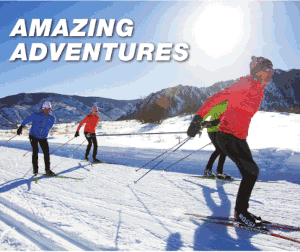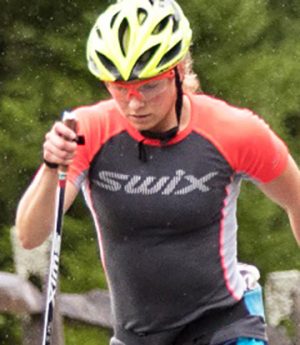But three days before the women’s team pursuit qualifying rides, Canada has broken the world record in training – at least unofficially. Who knows what the other teams have done – but suffice to say the Canadians are pleased. Jasmin Glaesser, who moved from Germany to the West Coast as a little girl, became injured as a runner and took off on her dad’s mountain bike immediately fell in love with her new ability to fly. Her first formal competitive experience was with Escape Velocity’s Women’s Learn to Ride Program.
It’s a four-week program that is designed to take women from recreational to skilled cyclists and gives them a taste of all the racing disciplines. Glaesser realized she was a road and track rider. That was in 2010 – a mere two years later, at barely twenty-years of age, she is setting world records. This U of Victoria student is driven.“This track is really fast-it’s a bit of a confidence booster,” she told Pedal after a morning training session. “But I think everyone’s is having fast times.” She says this as Great Britain women’s team pursuit team prepare to train behind them. “I think anything less than a medal would be disappointing. The crowd is so in love with the sport,” she adds, about the velodrome fans. “It’s really motivating and so exciting.”
Glaesser believes the track team has had a good training camp on the continent and that it was helpful “…to go away as a group and just focus on things, but also getting to here now, and being part of Team Canada-that’s really nice.”
From Glaesser, who just celebrated her twentieth birthday on July 8, to team veteran Tara Whitten, who turned thirty-two a week later, the pursuit team is just so packed with talent. Whitten adds, “We’re really happy with the way training has gone. Our team has really come together.” The seasoned athlete, who came from the national cross-country ski team to cycling eight years ago, adds, “It’s incredible to see the improvement of the other girls. They are really coming into their own.”She has an ear to ear grin, after working more on the Omnium than the team pursuit, as alternate Laura Brown of Calgary can take her place during training. “Oh I love this track. It’s just so smooth and you feel a lot of speed. Judging from the temperature in here it’s going to be quick.”
The team pursuit is scheduled first, which she says helps in terms of getting rid of first race jitters and is actually an advantage going into the Omnium.
“Overall it’s an endurance event,” she commented to Pedal of the Omnium. “The main focus of training would be aerobic fitness. But the speed component is there too. For me, if I am fit, the speed is there.”In terms of training for two events – one of which has multiple components – Whitten says, “It’s just a balancing act. You try to take advantage of your strengths. I know which events I can count on.”
Whitten, who was a PhD student in neuroscience before training full-time for the Olympics, says coming to a sport where neuroscience plays a huge role, isn’t necessarily an advantage. “Sometimes it hinders me. Sometimes in mass-start races, over analyzing is not best. It’s better to act on instinct – not process too much. But I do like to understand things and really, over the past few years I’ve learned so much about how my body works and responds to training.”
Gillian Carleton, like Glaesser is a young, talented athlete with a few more Olympics beyond London in her future. She showed early talent by winning the Canada Games as a teen-ager, but decided to pursue studies at U of Victoria in biology instead after getting “burned out” while only a teen-ager. Cycling still pulled though and it was her involvement in alleycat and fixed wheel non-sanctioned racing in the streets of Victoria that brought her back to the sport.“Last year a group of friends and I got involved in fixing up the Victoria velodrome. It had been closed for a long time and we got it opened,” she said of the 1994 Commonwealth Games Velodrome that was supposed to become a legacy for cycling and instead fell into disrepair when local municipalities did not maintain it. “Messenger and fixed gear community started coming out in 2011 and that’s when I started riding the track.”
Carleton says from putting back together a track one year and racing at the Olympics the next has made her “super awestruck.” Tara Whitten is her mentor and she loves “…the strong women presence on the team” adding, “Every time we get to do a race that the Brits are in, we learn so much. It’s really motivating.”
More a sprinter than an endurance athlete in her own eyes, Carleton says she, “…would really be interested in doing a four person 4000 metre team pursuit,” – like the men do. “I contribute a lot from the start with three women, and we have to finish three so you could say it’s harder for the women. But if we did 4,000, and there were only three to finish, like the men, then I could drop off once I did my job.”
Without question Canada and many other countries could easily field a four-woman team pursuit team. The UCI and the IOC say women’s cycling needs to “develop” more, but they give no statistics to back up their decision to not make the team pursuit – which will appear for the first time for women at these Games – equal to the men’s race from the start. This decision was arbitrary, like all decisions limiting the amount of women cyclists at the Olympics.
Case in point is Canada’s alternate, Laura Brown. This morning it was she who was the third rider in training when the team unofficially broke the world record. “It’s a good feeling to do training sessions under world record times” says Brown, from Calgary. “I do the exact same thing as the team. Tara can focus on the omnium. At any moment I can be put in.”Brown says when the women’s team pursuit was added to the World Championships in 2008… “there were just not the numbers” – to have four women per country per team – “but now there are many countries I can name that could field four women and still have an alternate. It would be nice if we could have four riders over four kilometers.”
Brown doesn’t mention it, but if the women had the same opportunity as the men, she would be contesting the team pursuit in London, not standing on the sidelines as an alternate.
The Women’s Team Pursuit qualifications start Friday, August 3. The Women’s Omnium starts Monday, August 6.






![National camp action [P]...](https://skitrax.com/wp-content/uploads/2019/08/Duluth-4-2019-08-08-at-10.46.51-AM-300x246.png)
![Matt Liebsch on the CXC Elite Team [P] CXC...](https://skitrax.com/wp-content/uploads/2019/08/Matt-Liebsch-CXC.2-525x700.4-300x267.jpg)
![Dan LaBlanc [P]...](https://skitrax.com/wp-content/uploads/2019/08/Dan-LaBlanc-img_1855.3.jpg)

![Canadian Women's Pursuit Team training [P] Heinz Ruckemann](http://pedalmag.com/wp-content/uploads/2012/07/W-Pursuit-OLY20120731907-525x347.jpg)
![Jasmin Glaessar [P] Heinz Ruckemann](http://pedalmag.com/wp-content/uploads/2012/07/OLY20120731913.2-525x538.jpg)
![Tara Whitten, the veteran world champ on the team. [P] Heinz Ruckemann](http://pedalmag.com/wp-content/uploads/2012/07/Whitten-OLY20120731908-525x371.jpg)
![Tara Whitten [P] Heinz Ruckemann](http://pedalmag.com/wp-content/uploads/2012/07/Whitten-OLY20120731903-500x760.jpg)
![Gillian Carleton [P] Heinz Ruckemann](http://pedalmag.com/wp-content/uploads/2012/07/Gillian-Carleton-OLY20120731905-525x350.jpg)
![Laura Brown... [P] Heinz Ruckemann](http://pedalmag.com/wp-content/uploads/2012/07/OLY20120731912.2-525x525.jpg)
August 1st, 2012 at 11:10 am
I thought this was the SkiTrax web site—-not Pedal?!!!